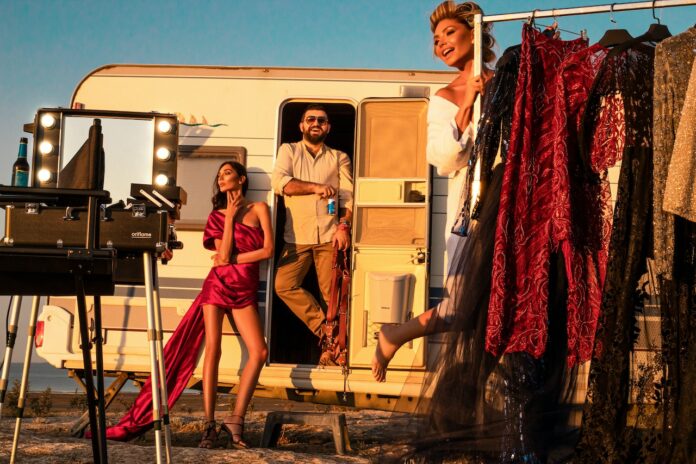Throughout cinematic history, fashion has played a pivotal role in shaping memorable characters and defining film culture. The medium of film is a powerful platform for designers to showcase their talent, and their creations can leave a lasting impact on both the industry and audience.
In this blog post, we’ll explore some of the most iconic outfits that have graced the silver screen, forever ingrained in our collective memory as quintessential examples of cinematic style.
Breakfast At Tiffany’s (1961) – Audrey Hepburn’s Little Black Dress
Arguably one of the most iconic outfits in film history, Audrey Hepburn’s portrayal of Holly Golightly in Breakfast at Tiffany’s made the little black dress a wardrobe staple.
Designed by Hubert de Givenchy, the elegant black sheath dress paired with pearls, oversized sunglasses, and a chic updo became synonymous with Hepburn’s refined style and continues to inspire fashionistas to this day. A great example can be found at Temu.
The Seven Year Itch (1955) – Marilyn Monroe’s White Halter Dress
Marilyn Monroe’s famous subway grate scene in The Seven Year Itch is unforgettable, not only for the actress’s magnetic screen presence but also for the billowing white halter dress she wore.
Designed by William Travilla, the dress accentuated Monroe’s voluptuous figure and has since become a symbol of femininity and allure.
Bonnie And Clyde (1967) – Faye Dunaway’s Beret And Suit
Faye Dunaway’s portrayal of Bonnie Parker in the 1967 crime drama Bonnie and Clyde brought the power of fashion to the forefront of the film.
Costume designer Theadora Van Runkle crafted a chic wardrobe that included a fitted skirt suit, silk blouse, and a jaunty beret, all of which contributed to Bonnie’s sophisticated, yet rebellious, image.
Saturday Night Fever (1977) – John Travolta’s White Disco Suit
John Travolta’s white three-piece suit in Saturday Night Fever is emblematic of the disco era and its impact on fashion. Designed by Patrizia von Brandenstein, the suit’s flared pants, wide lapels, and fitted waistcoat encapsulate the flamboyant energy of the 1970s dance scene, and it remains a symbol of the era’s distinctive style.
Annie Hall (1977) – Diane Keaton’s Menswear-Inspired Look
Diane Keaton’s portrayal of the titular character in Woody Allen’s Annie Hall revolutionized women’s fashion with her menswear-inspired ensembles.
Costume designer Ruth Morley collaborated with Keaton to create a unique wardrobe that included baggy trousers, vests, and oversized ties. The look quickly gained popularity and gave rise to the “Annie Hall” style that remains influential in contemporary fashion.
Pulp Fiction (1994) – Uma Thurman’s Black Bob Wig And White Shirt
Uma Thurman’s character Mia Wallace in Quentin Tarantino’s Pulp Fiction is renowned for her striking black bob wig and crisp white button-down shirt.
Costume designer Betsy Heimann curated a minimalist yet powerful look for Thurman, pairing the shirt with black pants and a Chanel Vamp nail polish, creating an edgy style that still resonates with audiences today.
The Devil Wears Prada (2006) – Anne Hathaway’s Complete Transformation
In The Devil Wears Prada, Anne Hathaway’s character, Andy Sachs, undergoes a complete fashion transformation under the tutelage of Meryl Streep’s Miranda Priestly.
Costume designer Patricia Field crafted a series of stylish ensembles that showcased high fashion and runway trends, allowing Hathaway’s character to evolve from frumpy to fabulous.
The film’s wardrobe, including designer pieces from Chanel, Prada, and Valentino, serves as a testament to the transformative power of fashion and its impact on personal identity.
Black Panther (2018) – The Afrofuturistic Costumes
In the groundbreaking Marvel film Black Panther, costume designer Ruth E. Carter brought the world of Wakanda to life through a unique blend of traditional African aesthetics and futuristic elements.
The vibrant and intricately detailed costumes, such as Dora Milaje’s armor and T’Challa’s Black Panther suit, showcase the richness of African culture and have left a lasting impression on the fashion world.
Conclusion
In conclusion, these unforgettable ensembles, ranging from the enduring elegance of Audrey Hepburn’s little black dress to the groundbreaking Afrofuturistic creations in Black Panther, have left indelible marks on both cinematic and fashion history. They demonstrate the profound influence of fashion in film, as each outfit contributes to crafting compelling narratives and forming unforgettable characters. Reflecting on these landmark fashion moments, we recognize the lasting significance of costume design in shaping our perceptions of style and its essential place within the realm of motion pictures.


